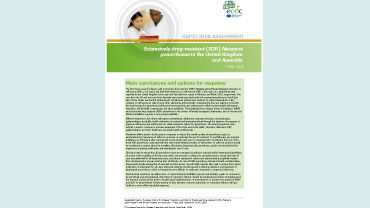Extensively drug-resistant gonorrhoea: risk of further dissemination within and across Europe
ECDC comment on the study 'Detection in the United Kingdom of the Neisseria gonorrhoeae FC428 clone, with ceftriaxone resistance and intermediate resistance to azithromycin, October to December 2018' by Eyre et al. in the Eurosurveillance edition of 7 March 2019.
The study by Eyre et al. in the Eurosurveillance edition of 7 March 2019 reported on two cases of ceftriaxone-resistant Neisseria gonorrhoeae with intermediate resistance to azithromycin diagnosed in England. The two female patients presented in October and November 2018 and developed symptoms following unprotected sex with UK residents, the first during holiday in Ibiza and the second with a man who had been in Ibiza with links to the same sexual network as the first case.
Cultures from both cases yielded N. gonorrhoeae resistant to ceftriaxone, cefixime, tetracycline, penicillin and ciprofloxacin and with intermediate resistance to azithromycin. The isolates were sensitive to spectinomycin and had low MIC values for gentamicin and ertapenem suggesting susceptibility to these agents, although breakpoints are not defined. The first case was treated successfully with intramuscular ceftriaxone and oral azithromycin according to UK national treatment guidance at the time.
The second case failed treatment with ceftriaxone intramuscularly and later with intramuscular gentamicin and oral azithromycin, but eventually cleared infection following treatment with ertapenem intravenously 1 g once daily for three days. The second case also had unprotected oral and protected vaginal sex with a male partner when her symptoms initially improved following treatment with ceftriaxone and her partner tested positive with nucleic acid amplification test at the pharynx (pharyngeal culture and urine NAAT were negative). Since it was considered likely that he was infected by the second case, the partner was successfully treated with ertapenem intravenously.
The isolates were sequenced and shown to be indistinguishable and comparisons with previously reported ceftriaxone-resistant isolates indicated that they were part of the FC428 clone that likely originated in Southeast Asia or China before spreading to multiple countries.
ECDC comment
Infections with multidrug- and extensively drug-resistant N. gonorrhoeae that are part of the FC428 or other clones have been reported from several countries worldwide in the last two years. In 2018, ECDC published a rapid risk assessment on three cases that were diagnosed in Australia and England, two of whom had links to Southeast Asia. Additionally, cases have been reported in Canada, Denmark, France and Ireland. Some of these cases reported sexual intercourse with new partners while travelling in Asian countries. However, for the case reported in France and the two recent infections in the UK, it is likely that transmission happened in Europe.
This development is of concern as it is likely that the detected cases represent only a small proportion of the real burden caused by these multidrug-resistant clones. A large proportion of gonorrhoea cases are asymptomatic and additionally, some could be cleared spontaneously. In these situations, opportunities for detecting these strains and stopping transmission will be missed. Although both the cases in the current report were UK residents, the links to Ibiza, a popular destination for young Europeans, suggest that there is a risk of further dissemination of this strain within and across Europe.
These reports highlight the importance of EU/EEA Member States adopting the measures included as options for response in the ECDC rapid risk assessment and response plan to control multidrug-resistant N. gonorrhoeae that include:
- strengthening surveillance for antimicrobial-resistant gonorrhoea
- implementation of treatment failure monitoring; and
- ensuring that gonorrhoea infections are managed appropriately according to national or European treatment guidelines, including the implementation of test of cure for all cases and effective partner notification.
Sexual health clinicians also need to be informed by public health institutes of this threat in order to be aware of possible cases.
However, effective response to the threat of drug-resistant gonorrhoea depends on a global approach. Strengthened surveillance and case management in regions where these strains are likely to have originated from is crucial in order to limit further spread.
Although both recently reported cases in the UK were successfully treated with ertapenem, use of the drug is not ideal. As mentioned by the authors, this approach may lead to the development of carbapenem resistance in other organisms where carbapenems are used for the treatment of multidrug-resistant infections.
In addition, sexual health clinics are not generally set up for gonorrhoea treatment with intravenous antibiotics for multiple days. New treatment options are urgently needed that are effective at all relevant anatomical sites.







